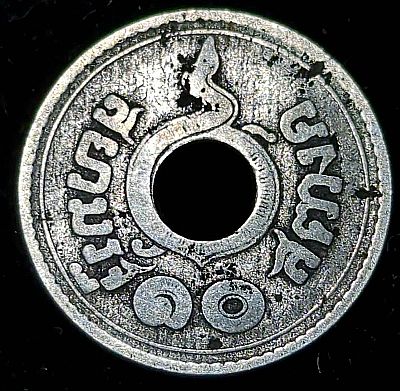Beautiful traditional Thai design which skipped a whole monarch

This coin stumped all our newsletter and social media followers. The beautiful pattern is described on Numista as a “Chakra with 8 blades”. Thailand is overwhelmingly Buddhist, 92.5% according to a 2021 report. I must confess, that not being overly familiar with the symbology used in Buddhism I actually had troubling finding more of a definition for this. If I’ve oversimplified anything, or flat out got it wrong, I apologise in advance. If you know more, please get in touch and I’ll be happy to update this post. Broadly though, wheels such as the Dharmachakra, are very important. As one of the oldest symbols, Dharmachakra represents Buddhism in a similar way to how the cross represents Christianity, or a Star of David represents Judaism. Wheels represent the perfection of Buddha’s teaching or the circular nature of time. An eight-spoked wheel represents the Eightfold path of Bhuddism, the means of enlightenment and eight main teachings of Buddhism (Understanding, Intention, Speech, Action, Livelihood, Effort, Mindfulness and Concentration).
Also on the reverse of the coin, just above the hole, is the date. Written “พ.ศ. ๒๔๖๒”, it denotes year 2462 of the Thai calendar. The Thai calendar is 543 years ahead of the western or Gregorian calendar. The calendar stars on April 13 and has twelve lunar months, each starting on a new moon. Text on the coin is written in Thai script.

The obverse of the coin is similarly elegant. It features the inscription – country name and value, around an Unalom, “It represents the path to freedom. Or slightly more down-to-earth, your life’s path. The sign consists of three parts: the spiral, the swirl, and the dots at the end. You read the Unalome from bottom to top.”
From a purely numismatic point of view, the top of the Unalom, and also the value below (the two round symbols), give an indication of where the coin was minted. See Numista for comparison photos. The coin was minted at three mints, Bangkok, Birmingham and Brussels. My example is from Brussels.
Numismatically, another curiosity of this coin is when it was minted. It’s run went from 1908 to 1937, a period which covered four Thai Kings: Rama V, Rama VI, Rama VII and Rama VIII. However, the coin was not minted at all between 1921 and 1935, so none were minted during the reign of Rama VII. I am curious if anyone knows, what is the longest gap in minting of a circulation coin? (Where it was minted before and also after the gap). Please contact me or comment below with your thoughts!


Leave a Reply